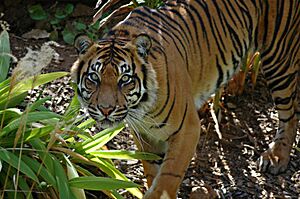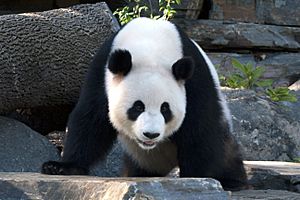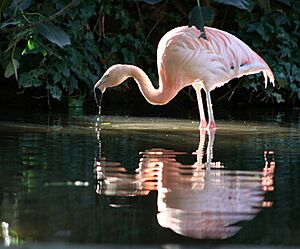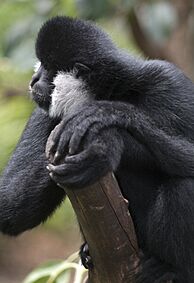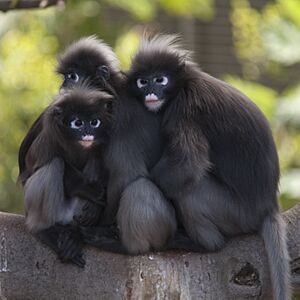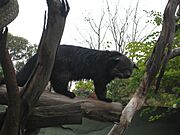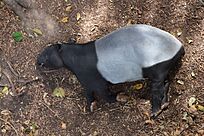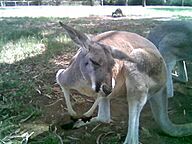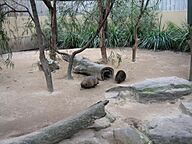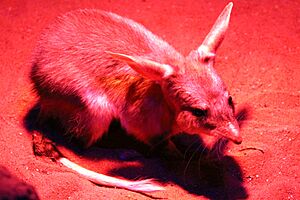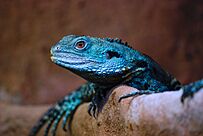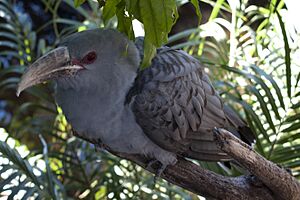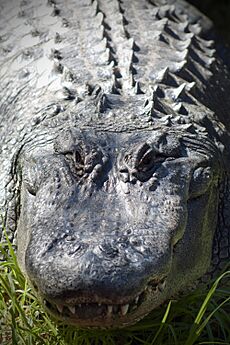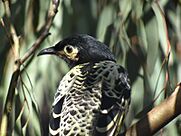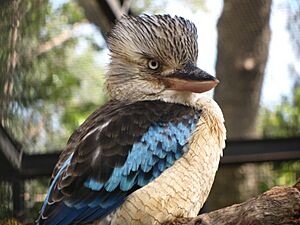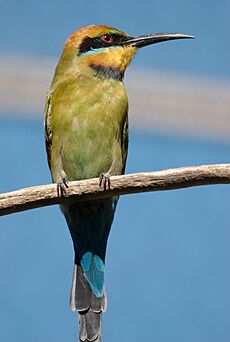Adelaide Zoo facts for kids
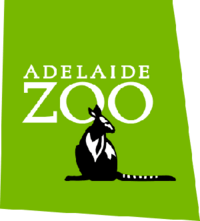 |
|
| Date opened | 23 May 1883 |
|---|---|
| Location | Adelaide, South Australia, Australia |
| Land area | 8 hectares (20 acres) |
| Coordinates | 34°54′51″S 138°36′21″E / 34.91417°S 138.60583°E |
| No. of animals | over 3,000 (as at September 2019) |
| No. of species | 300 |
| Memberships | Zoo and Aquarium Association, World Association of Zoos and Aquariums |
Adelaide Zoo is Australia's second oldest zoo (after Melbourne Zoo), and it is operated on a non-profit basis. It is located in the parklands just north of the city centre of Adelaide, South Australia. It is administered by the Royal Zoological Society of South Australia Incorporated (trading as Zoos South Australia or Zoos SA), which is a full institutional member of the Zoo and Aquarium Association and the World Association of Zoos and Aquariums, and which also administers the Monarto Safari Park near Murray Bridge.
The zoo houses 2,500 animals comprising 250 native and exotic species. The zoo's most recent enclosures are in the second phase of the South-East Asia exhibit, known as Immersion, providing visitors with the experience of walking through the jungle, with Sumatran tigers and Sumatran orangutans seemingly within reach.
Five buildings within the zoo have been listed as state heritage places on the South Australian Heritage Register, including the front entrance on Frome Road and the former Elephant House. The zoo is also a botanical garden and the grounds contain significant exotic and native flora, including a Moreton Bay fig planted in 1877.
The giant panda exhibit, which opened in December 2009, is home to two giant pandas, Wang Wang and Funi, which will remain at the zoo until at least 2024.
History
Adelaide Zoo opened on 23 May 1883, occupying 6.5 hectares (16 acres) (now 8 hectares (20 acres)) of land granted by the government. It was founded by the South Australian Acclimatization and Zoological Society. The society later became the Royal Zoological Society of South Australia after a royal charter was granted by King George VI in 1937.
The first director of the zoo, from 1882 to 1893, was R. E. Minchin. He was succeeded by his son A. C. Minchin from 1893 to 1934, and grandson R. R. L. Minchin from 1935 to 1940. Another grandson, Alfred Keith Minchin ran the private Koala Farm in the North Parklands from 1936 to 1960. The surplus koalas were set free on Kangaroo Island.
In the mid-twentieth century the zoo was involved in the export of live birds, with 99% of Australia's exports of live native birds, mainly finches and parrots for aviculture, passing through either Adelaide or Taronga (Sydney). At a time when the need for conservation of Australia's native birds, and control of their trade was becoming increasingly apparent, South Australia lagged behind other states in passing appropriate legislation.
In 1963, the government launched an investigation into the zoo's improper record-keeping of these birds. The new director of the zoo, William Gasking, was quickly dismissed through the power exerted by the Zoo Council president, Fred Basse, due to Gasking's attempts to address animal health and safety at the zoo. When Basse retired, the trade in birds dropped to one tenth of what it had been two years before. Since then, the zoo's administration has been restructured and the zoo has regained public credibility and scientific status.
The modern zoo has moved away from the traditional housing of species separately in pairs. Now species are grouped together as they would be in the wild, in exhibits that are carefully planned according to region. Enclosures have been designed with the needs of the animals in mind, providing a more natural habitat, which also serves an educational purpose for visitors. Although some of the zoo's heritage listed enclosures, such as the Elephant House that was built in 1900, have been retained, they are no longer used to house animals. The Elephant House now has educational signs. The last elephant housed at the Adelaide Zoo, Samorn, was moved to Monarto in 1991, where she died three years later.
The flamingo exhibit was opened in 1885, and is one of the few to have remained in the same position to date. Originally it was stocked with ten flamingos, most of which died during a drought in 1915. In 2014, one of two surviving greater flamingos in the exhibit, thought to be the oldest in the world at 83 years of age, died. The remaining Chilean flamingo at Adelaide zoo, the last flamingo in Australia, which arrived in 1948, was humanely euthanised on 6 April 2018.
The nocturnal house opened in 1974. The reptile house opened in 1985 and was expanded in 1993. The giant panda exhibit and Bamboo Forest opened in 2009. This replaced the former "South America Section" and ungulate paddocks. The former great ape compound behind the administration building was demolished and replaced by an education centre and envirodome in 2008-2009.
In 2010, the main entrance was relocated off Frome Road in place of the hoofed animal yards, which were demolished. The famous polychrome masonry and cast-iron gates of the original entry, built in 1883 and restored in 1992, have been preserved.
The zoo's restaurant is located in a brick building that was originally a monkey house. It was constructed in 1891, converted to a kiosk in 1936, and renovated in 1989.
-
An Asian small-clawed otter being fed a fish
-
The zoo is home to only Patagonian maras held in Australia
Current focus
The zoo has a particular focus on species from the Gondwana "supercontinent" which later broke up into South America, India, Africa, Australia and South East Asia. The botanic similarities between the regions are featured in the zoo's main exhibits, which include a South East Asian Rainforest, and Australian Rainforest Wetlands walk-through aviary. The South East Asian precinct combines Malayan tapir and dusky leaf monkeys in a shared exhibit together. Other exhibits are immersed next to each-other such as those for northern white-cheeked gibbons and siamangs on neighbouring rainforest lake islands.
The South East Asia Exhibit called Immersion was built in two parts. The first part was finished in 1995 which gave exhibits to animals such as siamangs and sun bears (the latter no longer held by the zoo). In late 2006 most of part two was finished which gave exhibits to Sumatran orangutans, siamangs and Sumatran tigers. There is also a large walk-through aviary which takes visitors past the two gibbon islands towards the tiger enclosures.
Adelaide Zoo has long been recognised for its impressive bird collection, but Australia's strict importation and quarantine laws make it unlikely that many exotic species will sustain genetically viable populations, a problem experienced by all zoos in the region. Importation of birds from overseas has been restricted in Australia since 1943, meaning additions to the exotic bird collection can only come from animals bred in the region or seized illegal imports, such as their hyacinth macaw specimen on exhibit. There are similar restrictions on acquiring many mammal species in Australia.
The zoo also has a focus on educational programs. There is a selection of "get to know the zoo" type of tours, a large "children's zoo" area, and from April 2009, an educational area for secondary school students and their teachers. Schools can hire the facility and groups can sleep there, with a member from the zoo supervising. Also, a new educational area called the Envirodome opened in April 2009. Night walks, tours and animal research can be done. More information on the educational programs can be found on the zoo's web site. The education building in the northeast corner of the zoo replaced the old ape grottos.
Animals
In 2023, the zoo housed more than 2,500 animals and 250 species. There were 1,300 animals of 282 species in 1990.
- Bamboo Forest
- South-East Asia
- South Australian Coast
- Australia
- Nocturnal House
- Black-footed tree-rat
- Brush-tailed bettong
- Common ringtail possum
- Eastern barn owl
- Fat-tailed dunnart
- Greater bilby
- Greater stick-nest rat
- Olive python
- Spinifex hopping-mouse
- Squirrel glider
- Reptiles House
- Adelaide pygmy blue-tongued lizard
- Amazon tree boa
- Aruba island rattlesnake
- Australian green tree snake
- Blood python
- Blue Mountains tree frog
- Blue poison dart frog
- Cane toad
- Carpet python
- Central bearded dragon
- Corn snake
- Desert death adder
- Dyeing poison dart frog
- Eastern blue-tongued lizard
- Elongated tortoise
- Freshwater crocodile
- Gila monster
- Gippsland water dragon
- Green anaconda
- Green tree python
- Growling grass frog
- Hosmer's spiny-tailed skink
- Inland taipan
- Komodo dragon
- Merten's water monitor
- Murray River short-neck turtle
- Painted burrowing frog
- Pernatty knob-tailed gecko
- Pig-nosed turtle
- Radiated tortoise
- Red eyed tree frog
- Red-bellied black snake
- Rosenberg's monitor
- Splendid tree frog
- Western swamp turtle
- Woma python
- Jewels of Asia Aviary
- Black-capped lory
- Black-winged stilt
- Channel-billed cuckoo
- Chattering lory
- Dollarbird
- Dusky lory
- Emerald dove
- Golden pheasant
- Luzon bleeding-heart dove
- Malabar parakeet
- Noisy pitta
- Palm cockatoo
- Purple ground dove
- Red lory
- Rose-crowned fruit-dove
- Rufous whistler
- Sacred kingfisher
- White-breasted ground dove
- South-East Asian Aviary
- Africa
- African lion
- African spur-thighed tortoise
- Aldabra giant tortoise
- Cape porcupine
- Congo grey parrot
- Eastern black-and-white colobus monkey
- Egyptian goose
- Fennec fox
- Giraffe
- Hamadryas baboon
- Helmeted guineafowl
- Mandrill
- Meerkat
- Namaqua dove
- Orange-breasted waxbill
- Pygmy hippopotamus
- Red fody
- Red-billed firefinch
- Red-cheeked cordon-bleu
- Ring-tailed lemur
- Serval
- Southern red bishop
- Yellow-collared lovebird
- Yellow-fronted canary
- Americas
- American alligator
- Blue-and-yellow macaw
- Blue-crowned parakeet
- Bolivian squirrel monkey
- Brazilian tapir
- Brown-throated conure
- Crimson-bellied parakeet
- White-bellied parrot
- Maned wolf
- Maroon-bellied parakeet
- Nanday parakeet
- Patagonian mara
- Red-bellied macaw
- Rhinoceros iguana
- Scarlet macaw
- South American coati
- Sun conure
- Yellow-crowned amazon
- Tamarin House
- Birds of the Adelaide Hills Aviary
- Australian Rainforest Birds Walkthrough Aviary
- Ponds and Wetland Walkthrough Aviary
- Birds of the Australian Desert Aviary
- Other Australian Habitat Aviaries
- Adelaide rosella
- Australasian shoveler
- Australian king quail
- Australian bustard
- Australian owlet-nightjar
- Australian wood duck
- Banded lapwing
- Banded stilt
- Bar-shouldered dove
- Barking owl
- Black-and-white fairywren
- Black-breasted buttonquail
- Black-eared miner
- Blue-faced honeyeater
- Blue-winged kookaburra
- Brown cuckoo-dove
- Brush bronzewing
- Carnaby's black cockatoo
- Chestnut-breasted mannikin
- Cloncurry ringneck parrot
- Crested bellbird
- Crested pigeon
- Crimson rosella
- Diamond dove
- Double-barred finch
- Dusky woodswallow
- Eastern grass owl
- Eastern whipbird
- Eastern yellow robin
- Elegant parrot
- Flock pigeon
- Freckled duck
- Gang-gang cockatoo
- Golden-shouldered parrot
- Gouldian finch
- Green pygmy goose
- Grey butcherbird
- Hooded dotterel
- Hooded parrot
- Hooded robin
- Laughing kookaburra
- Long-billed corella
- Long-tailed finch
- Magpie goose
- Major Mitchell's cockatoo
- Malleefowl
- Mulga parrot
- Musk lorikeet
- Naretha bluebonnet
- New Holland honeyeater
- Northern rosella
- Olive-backed oriole
- Orange-bellied parrot
- Painted finch
- Partridge pigeon
- Port Lincoln ringneck parrot
- Princess parrot
- Purple-crowned lorikeet
- Radjah shelduck
- Rainbow bee-eater
- Red-backed kingfisher
- Red-browed finch
- Red-capped parrot
- Red-collared lorikeet
- Red-tailed black cockatoo
- Red-winged parrot
- Rose-crowned fruit dove
- Spinifex pigeon
- Star finch
- Superb fairy-wren
- Superb parrot
- Tawny frogmouth
- White-browed woodswallow
- White-winged triller
- Yellow-tailed black-cockatoo
- Variety Children's Zoo
- Alpaca
- Black-footed tree-rat
- Domestic chicken
- Domestic goat
- Domestic rabbit
- Fallow deer
- Guinea pig
- Hermann's tortoise
- Indian antelope
- Quokka
- Spur-thighed tortoise
- Envirodome
- The Envirodome is an interactive visitor experience housed in the old Ape Block along with the Education Centre. The non-animal exhibits are hands-on and are aimed at the conservation of our environment, hoping to educate the public on simple changes they can make to help the environment. The building itself has been largely recycled and has a green roof, rain-water fed toilets, hay-bale walls and solar panels. Animals housed in the Environdrome include yellow seahorse.
Incidents
In September 1909, the Strand Magazine reported that a snake had swallowed a rug weighing almost 12 pounds (5.4 kg), and which survived undamaged in the snake's stomach until disgorged almost a month later. The short article featured a photograph of the disgorged rug which was 5 feet 3 inches (1.60 m) long. Contemporary (1894) accounts had the size of the rug, which was kept in the enclosure for the boa constrictor's comfort, at 7 by 6 feet (2.1 m × 1.8 m), and after disgorgement weighed 5.5 pounds (2.5 kg), dried.
On Mother's Day 2009, the female orangutan, Karta, built an escape route out of plant material and tripped the hot wires with a stick. After a short while on the "outside" she dropped back into the exhibit with no harm done.
On 12 August 2022, a newly-arrived red panda, Ravi, escaped from its enclosure, before being located in a tree at the Botanic Park on 14 August. The red panda was tranquilised after keepers failed to entice it down with food.
Notable animals
The last captive Javan rhino was displayed at the Adelaide Zoo as an Indian rhinoceros due to the lack of knowledge about this species. It died in 1907.
The last American beaver at the zoo died in July 2010 and was the last beaver to be held at any zoo (or anywhere) in Australia.
Miss C, the last Hoffmann's two-toed sloth in Australia and the oldest in the world died in June 2017 aged 43.
Wang Wang and Funi are two giant pandas on loan to Adelaide Zoo in Australia, as part of a conservation program to protect endangered wildlife.
Yiray the quokka, one of the Australia-native threatened species at the Adelaide Zoo, gave birth to a baby in March 2022.
See also


